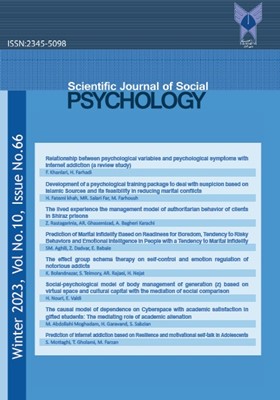A qualitative study: Explaining the management model of authoritarian behavior of clients in Shiraz prisons
Subject Areas : social psychology
Zhila rastagari Nia
1
![]() ,
Alireza Ghasemizad
2
,
Amin Bagheri Karachi
3
,
Alireza Ghasemizad
2
,
Amin Bagheri Karachi
3
1 - PhD Student in Educational Management, Department of Educational Management, Kazerun Branch, Islamic Azad University, Kazerun, Iran,
2 - Assistant Professor of Higher Education Management, Department of Educational Management, Kazerun Branch, Islamic Azad University of Kazerun, Iran
3 - Assistant Professor, Department of Educational Sciences:, Farhangian University, Tehran, Iran.
Keywords: Qualitative research# authoritarianism# family structure and family styles,
Abstract :
One of the strong tendencies in human beings is "authoritarianism" or "power-seeking" which appears in the first years of a child's life in human beings, and to the extent that the child is empowered, this tendency is activated in him and his actions and behavior are directed. Gives. Therefore, the purpose of this study was to explain the pattern of management of authoritarian behavior among prisoners. The present study was conducted with a qualitative approach using content analysis method and using purposive sampling. The research tool was a semi-structured interview and data collection was continued until the theoretical saturation of the data was achieved. Using the content analysis method, 24 clients of Adelabad prison in Shiraz were interviewed. .The findings led to the extraction of several indices that reflect the participants' experiences of the consequences of authoritarianism, including family styles, family upbringing pattern and prison environment. The result was that family factors, positive and negative family pattern structure, family upbringing styles status The structure and context of the prison affect the tendency of individuals to authoritarianism and can cause serious damage to the entire family system, living environment and even the body of society. Abnormal individual position was presented as the main theme of the study.
آراسته، محمدو سبا شریفی(1387) شیوع اختلالات روانپزشکی در میان زندانیان زندان مرکزی سنندج ، بخش غربی ایران. ترجمه مسعود زاده علائم نرم افزار عصبی در زندانیان مرد: یک مطالعه مقطعی ،فصلنامه اصلاح و تربیت، 12(3)، 23-28.
ابراهیم زاده گرجی،سمیه.(1389).مداخلات شناختی –رفتاری-گروهی برمدیریت خشم ابراز وجود و سازگاری در نوجوانان مبتلا به اختلال سلوک ،مجله روانشناسی معاصر،مجموعه مقالات سومین کنگره انجمن روانشناسی ایرانی، 2-23.
احمدی،عبداله ونیکپور، جلال. (1389).تأثیر استفاده از مجازات مجرمیت جنایات افزودنی مواد مخدر بر وضعیت سلامت روانی همسر آنها. مجله راهبردهای حقوقی ، 2(1)، 23-26.
بدری،رحیم،حسینی،سید عدنان،هاشمی،تورج،میر نسب،میرمحمود(1397).طراحی برنامه آموزشی ضد قلدری تلفیقی و تعیین اثربخشی آن برکاهش قربانی شدن دانش آموزان دوره اول متوسطه ،نشریه علمی پژوهشی –آموزشی وارزشیابی، 11(41)، 55-81.
ﺑﻴﺮاﻣﻲ ، ﻣﻨﺼﻮر ،ﻋﻼﺋﻲ پروانه،(1394)، ﺷﻴﻮه ﻧﻘﺶ ﻫﺎی ﻓﺮزﻧﺪﭘﺮوری و ادراک از ﻣﺤﻴﻂ ﻋﺎﻃﻔﻲ ﺧﺎﻧﻮاده، مجله روانشناسی مدرسه، 2(3)، 38-56.
ﭘﻮرﻃﺎﻟﺐ ،ﻧﺮﮔﺲ، ﻣﻴﺮﻧﺴﺐ، میرﻣﺤﻤﻮد.(1398). ﻣﻘﺎﻳﺴﻪ ﺳﺒﻚ هویت دانش آموزان ﺑﺎ رﻓﺘﺎرﻫﺎی ﻗﻠﺪری، ﻗﺮﺑﺎﻧﻲ وداﻧﺶ آﻣﻮزانﻋﺎدی، نشریه علمی پژوهشی آموزش و ارزشیابی. 9(36)، 131-145.
چالمه، رضا (1392). کفایت روانسنجی مقیاس قلدری ایلی نویز در دانش آموزان ایرانی،بررسی روایی ، پایایی و ساختار عاملی ،فصلنامه روشها و مدلهای روان شناختی، 3(11)، 39-52.
زالی زاده ،مسعود.باقری،معصومه و ملتفت ،حسین.(1398).بررسی عوامل خانوادگی موثر برمدارای اجتماعی دانشجویان دانشگاه شهید چمران اهواز، نشریه مدیریت علمی دانشگاه اصفهان، 29(70)، 129-146.
زراعت ،زهراو غفوریان،علیرضا،(1388)اثربخشی آموزش حل مساله بر خود پنداره تحصیلی دانشجویان اقتدارگرا. مجله راهبردهای آموزشی، 2(1)، 23-26.
سلیمی،سید حسن.(1382).مطالعه تاثیر رفتار معلم بر نظم پذیری دانش÷آموزان در مدرسه. فصلنامه نوآوری های آموزشی، 2(6)، 103-115.
سید زاده ثانی،سید مهدی،عبدالهی ،احمد رفیع (1398). شیوع قلدری سنتی و سایبری در بین نوجوانان شهر هرات-افغانستان. 17(2)، 197-211.
محمدپور، احمد(1393). روش تحقیق کیفی ضد روش 1(منطق و طرح در روش شناسی کیفی). چاپ دوم، تهران، انتشارات جامعه شناسان.
Adorno T. W., Frenkel B. E., Levinson D. J., Sanford R. N. (2004). The Authoritarian Personality New York: Harp.
Goossens, F., Olthof, T., & Dekker, P. (2018). New participant role scales: Comparison between various criteria for assigning roles and indications for their validity. Aggressive Behavior, 32, 343–357.
Graneheim, U.H., Lundman, B. (2018). Qualitative content analysis in nursing research: Concepts, procedures and measures to achievetrust worthines.
Janson, G.R., Hazler, R.J. (2016) ‘Trauma Reactions of Bystanders and Victims to Repetitive Abuse Experiences. Violence and Victims, 19, 239– 255.
Jeremy, D., Jewel, P.h., Keven, D., Stark, P.h. (2018). Comparing the family environments of adolescent with conduct or depression. Journal of Child Family, 12(1):77-89.
Hoy,W,K.,Tarter,C,J.,&Woolfolk Hoy,A.(2006)Acade mic optimisim of schools:A force for student achievement.American Educational Research Journal,43,425-446.
Murberg, T.A. (2012). The influence of optimistic expectations and negative life vents on somatic sympomsamong adolescents:a one year prospective study.Journal of psychology, 3(2),123-27
Patton, Q., M. (2016). How to use qualitative methods in evaluation. Sage publications Inc., Newsbury park, London, New Dehl.
Bermond, B., Bierman, D.J., Cladder, M.A., Moormann, P.P., Vorst. H.C. (2010).The cognitive and affective alexithymia dimensions in the regulation of sympathetic responses. International Journal of Psychophysiology, 75(3), 227-233.
Barkham, M., Hardy, G.E., Startup, M. (1996). The IIP-32: A short version of the Inventory of Interpersonal Problems. British Journal of Clinical Psychology, 35(1), 21-35.
Reynolds,C.F., Frank, E., Perel, J.M., Imber, S.D., Cornes, C., Miller, M.D., Mazumdar, S., Houck, P.R., Dew, M.A., Stack, J.A. (2015). Nortriptyline and interpersonal psychotherapy as maintenance therapies for recurrent major depression: a randomized controlled trial in patients older than 59 years. Jama, 28(1)39-45.
Wallace, G.R. (1994). Discipline that motivates. Journal of Instructional Psychology,21(4),371-374.
_||_


